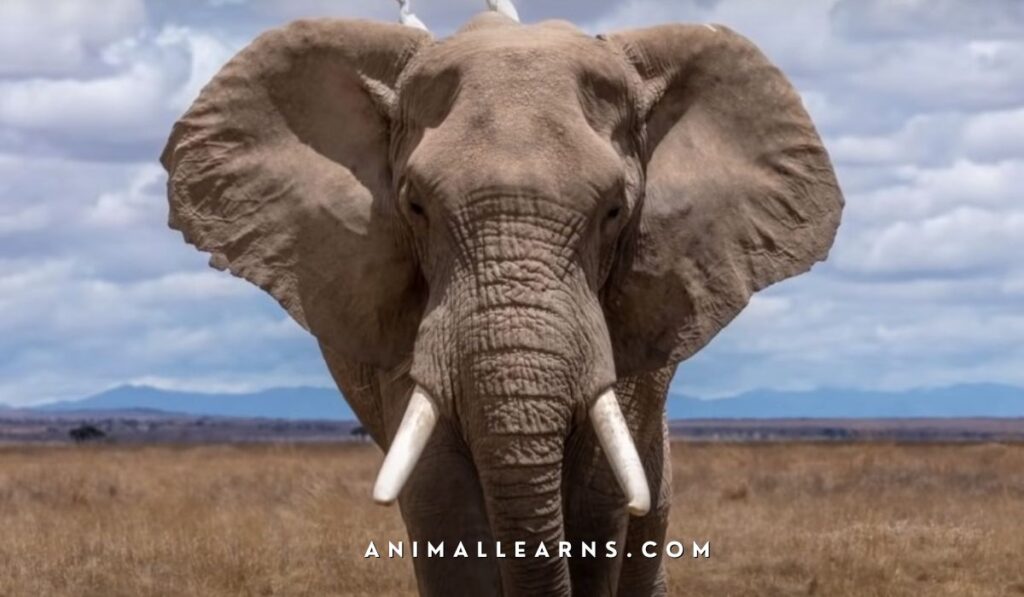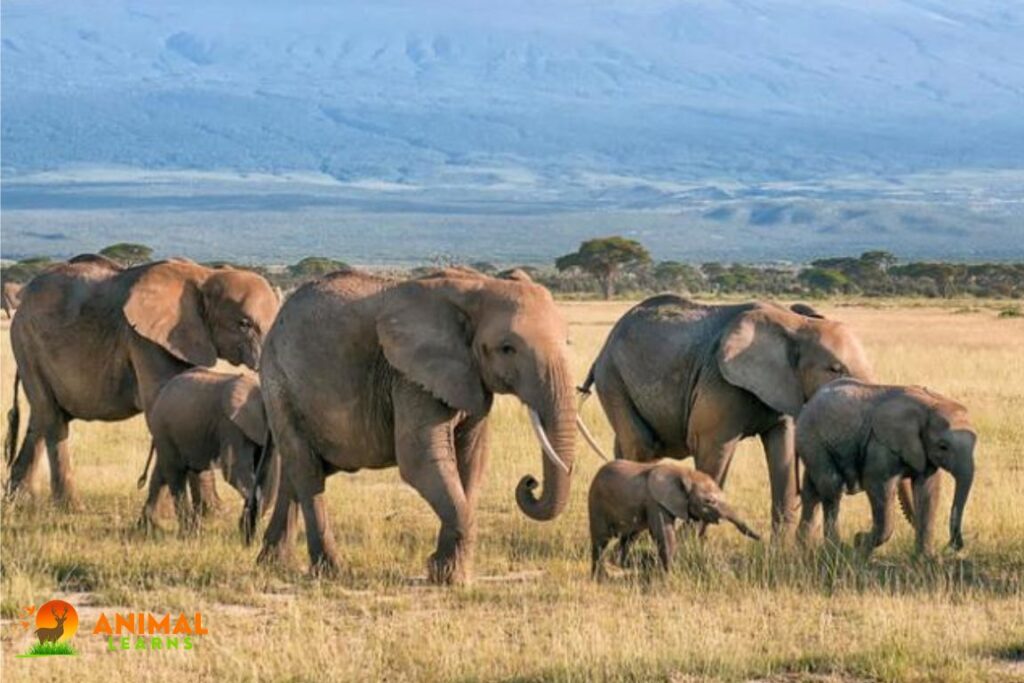African Elephants | Types, Facts & Habitat – Animallearns

The biggest land animal on Earth, African elephants are threatened by things like habitat degradation and poaching for their ivory tusks, thus conservation measures are essential to their survival.
That’s what it’s like to be near an African elephant, the world’s largest land animal. These amazing animals have a unique feature that sets them apart from other mammals—their trunk. An elephant’s trunk is not just a long nose, but a flexible and powerful organ that can do many things. It can smell, breathe, drink, spray, grab, and even make sounds.
Elephants need a lot of water to survive. They can drink up to 50 gallons (190 liters) of water a day. That’s more than a bathtub full of water. To drink, they use their trunk like a giant straw. They suck up water into their trunk and then squirt it into their mouth.
They can also use their trunk to spray water over their body to cool off or to dust themselves with mud or sand to protect their skin from the sun and insects.
But life is not easy for these gentle giants. They face many threats from humans and nature. Poachers kill them for their ivory tusks, which are used to make jewelry and other products. Their habitat is shrinking as humans clear land for farming and development.
They also come into conflict with humans when they raid crops or damage property. These problems have caused their numbers to drop dramatically over the years.
| Attribute | African Elephant |
| Name | African Elephant |
| Scientific Name | Loxodonta africana (African Savanna Elephant) and Loxodonta cyclotis (African Forest Elephant) |
| Diet | Herbivorous |
| Average Height | Up to 3 meters (Savanna Elephant) |
| Average Weight | Up to 6 tonnes (Savanna Elephant) |
| Up to 2.7 meters (Forest Elephant) | |
| Up to 2.7 tonnes (Forest Elephant) | |
| Trunk Length | About 7 feet (2 meters) |
| Ears | Larger, resembling the shape of Africa |
| Conservation Status | Savanna Elephant: Endangered |
| Forest Elephant: Critically Endangered |
African Elephant’s Size and Weight
Contents
The African elephant, known for its remarkable size and weight, stands as one of the planet’s most majestic creatures. A male African elephant can reach towering heights of up to 13 feet and weigh a staggering average of 15,000 pounds, making them the largest land animals on Earth.
Their impressive dimensions are further highlighted when comparing them to their Asian counterparts, as elephants tend to be slightly larger. Not only are their size and weight remarkable, but their appearance also holds unique features, such as their distinctive large ears that resemble the shape of the African continent.
Behaviors and Adaptations
Beyond their physical attributes, They display fascinating behaviors and adaptations. They are highly social animals, forming close-knit family herds led by a matriarch.
Their communication is rich, comprising vocalizations like trumpets and roars, along with trunk gestures and ear positioning. Their trunk, a versatile appendage, serves various purposes, from delicate tasks like picking up small objects to powerful actions like digging or delivering a forceful trumpet call.
Moreover, the African elephant’s lifespan averages around 60 to 70 years, reflecting its longevity and significance in the ecosystems it inhabits.
These remarkable creatures are not only vital components of the African wilderness but also symbols of the continent’s natural heritage.
Types
| Feature | African Savannah Elephant | African Forest Elephant |
| Scientific Name | Loxodonta africana | Loxodonta cyclotis |
| Size | Largest land animal: Up to 13 ft tall, 7.5 tons | Smaller: Up to 10 ft tall, 5.5 tons |
| Habitat | Open savannas, grasslands, even deserts | Dense rainforests |
| Ears | Very large, fan-shaped for heat regulation | More oval-shaped |
| Social Structure | Family groups of 10-12 females and calves, bulls associate during mating | Family groups of up to 20 individuals |
| Diet | Grasses, leaves, fruits | Leaves, bark, fruits, seeds |
| Population Status | Endangered | Critically Endangered |
| Distribution | 23 sub-Saharan countries | Central and West Africa |
| Threats | Poaching, habitat loss | Poaching, habitat loss, mining |
African Savannah Elephant (Loxodonta africana):

Imagine standing next to an animal that is as tall as a two-story building. That’s how big the African savannah elephant is. It is the largest land animal in the world, and it lives in the open plains and woodlands of sub-Saharan Africa.
A male savannah elephant can be up to 13 feet (4 meters) tall at the shoulder, and weigh as much as 13,000 pounds (6,000 kilograms). That’s about the same as three cars! They have long tusks that help them dig for water and defend themselves from predators. They also have large ears that help them cool down in the hot sun.
The African savannah elephant is a magnificent creature that deserves our respect and admiration. However, it is also facing many threats from humans, such as habitat loss, poaching, and conflict.
Their numbers are declining rapidly, and they need our help to protect them and their homes. That’s why conservation efforts are very important to ensure their future survival.
By supporting organizations that work to save the elephants, we can make a difference for these amazing animals and the ecosystems they live in.
African Forest Elephant (Loxodonta cyclotis)

The African forest elephant is smaller in size than the savannah elephant, and it has a darker skin color. A male forest elephant can be between 7 to 10 feet (2 to 3 meters) tall at the shoulder, and weigh between 4,000 to 8,000 pounds (1,800 to 3,600 kilograms). That’s still very big, but not as big as the savannah elephant.
They live in the dense forests and rainforests of Central and West Africa, where they eat mostly leaves, bark, and seeds. They have shorter, straighter tusks that help them navigate through the thick vegetation. They also have smaller, rounder ears that suit their forest habitat.
The African forest elephant is a fascinating creature that has adapted to its environment. It is also very intelligent and social, and it communicates with other elephants using sounds and gestures.
It is a wonderful animal that deserves our respect and admiration. However, it is also facing many threats from humans, such as habitat loss, poaching, and conflict.
Their numbers are declining rapidly, and they need our help to protect them and their homes. That’s why conservation efforts are very important to ensure their future survival.
By supporting organizations that work to save the elephants, we can make a difference for these amazing animals and the ecosystems they live in.
Both types of elephants have amazing adaptations that allow them to survive in their different environments. They are also very intelligent and social animals that communicate with each other using sounds and gestures. They are truly wonderful creatures that deserve our respect and admiration.
The Challenges Facing the African Elephants
Both types of African elephants need water sources for their survival. They need to drink water every day, which affects where they go and how far they travel. They also have a big impact on their habitats by changing the plants and creating paths for other animals.
However, they are facing many dangers that threaten their existence. Some of these dangers are:
Habitat loss
Humans are cutting down their habitats by chopping down trees, clearing land for farming, and building roads and cities.
Human-elephant conflict
Humans and elephants are fighting for resources like crops and water sources. This leads to fights that often hurt or kill both sides.
Poaching
Humans are hunting elephants for their ivory tusks, which are sold illegally in the black market.
To save the elephants, conservationists are working hard to keep their habitats safe, reduce fights between humans and elephants, and stop hunting for ivory. They hope to protect these wonderful animals and the environments they live in for future generations.
Where Do Elephants Live?

African elephants inhabit 37 countries in sub-Saharan Africa, with approximately 70% in Southern Africa, 20% in Eastern Africa, 6% in Central Africa, and 3% in West Africa.
These majestic creatures require vast expanses of land to find sufficient food and water, with the ability to roam across more than 30,000 sq km. However, the available space for elephants in Africa has decreased by over half since 1979.
While some secure areas show thriving populations with increasing numbers, in other regions, elephants are compelled to reside in smaller, isolated groups, leading to dangerously low population levels.
African Elephant facts

- The largest terrestrial animals on Earth are elephants, which may grow to a height of 13 feet and a weight of 15,000 pounds in males.
- Their unusual, enormous ears act as natural cooling mechanisms to help them control their body temperature in the hot climate of Africa.
- They have a complex social structure. They form close-knit family units under the leadership of a matriarch, who is the oldest and most seasoned female.
- They use a variety of vocalizations, such as trumpets and roars, as well as trunk motions and ear positions, to communicate.
- They live an average of 60 to 70 years in the wild, which is a fairly lengthy lifespan.
- Their trunks are adaptable appendages that may be used to gather food, pick up small things with finesse, and even make loud trumpet cries.
- The existence of these majestic animals is at stake because of concerns like habitat degradation, ivory poaching, and human-elephant conflicts.
- They are important eco-engineers because they remove vegetation, make water holes, and spread seeds throughout their ecosystems.
- They exhibit sophisticated behaviors, such as showing emotional intelligence and grieving for the dead. They also create close ties with their herds.
WHY AFRICAN ELEPHANTS ARE SO IMPORTANT?
Elephants are important to their surroundings. They are “landscape architects” because, for example, they make clearings in forested places as they travel and feed, allowing new plants to sprout and forests to organically recover.
Then there is the spreading of seeds. Elephants frequently consume fruits and vegetation that contain seeds, which frequently reemerge undigested. It’s how many plants disperse. Furthermore, elephants can consume large seeds that other animals cannot.
Elephants are integral to the natural functioning of their environments; their absence would have negative effects on both the surrounding wildlife and the human population.
Conclusion
In conclusion, the African elephant is a magnificent animal that profoundly affects the natural world. It is a testimony to the wonders of the animal kingdom and a symbol of Africa’s abundant biodiversity due to its incredible size, distinctive adaptations, and intricate social activities.
These magnificent giants, nevertheless, are threatened by a number of issues, such as habitat destruction, ivory poaching, and confrontations between people and elephants. We must actively take steps to safeguard African elephants in order to acknowledge the crucial role they play in preserving the natural balance of their habitats.
FAQs
Is the African elephant the biggest elephant?
Yes, the African elephant is the biggest elephant species on Earth.
Who named the African elephant?
The African elephant was not given its name by a single person; rather, it has long been known by the descriptive term given to it by its home continent.
What are interesting facts about African elephants?
With males standing up to 13 feet tall and weighing up to 15,000 pounds, African elephants are the largest land mammals.
They can communicate across great distances using a variety of vocalizations and have distinctive, large ears that aid in controlling their body temperature.
African elephants are extremely social creatures that form close-knit family units under the leadership of a matriarch and exhibit sophisticated behavioral and emotional intelligence.
Why is the African elephant special?
The remarkable size, sharp intelligence, and sophisticated social behaviors of the African elephant make it unique. Additionally, it is a representation of Africa’s natural history and plays a significant part in forming its ecology.
Are African elephants friendly?
African elephants can display friendly and social behaviors within their herds but can also be unpredictable and potentially dangerous in certain situations.












